Germany Container Glass Market Size
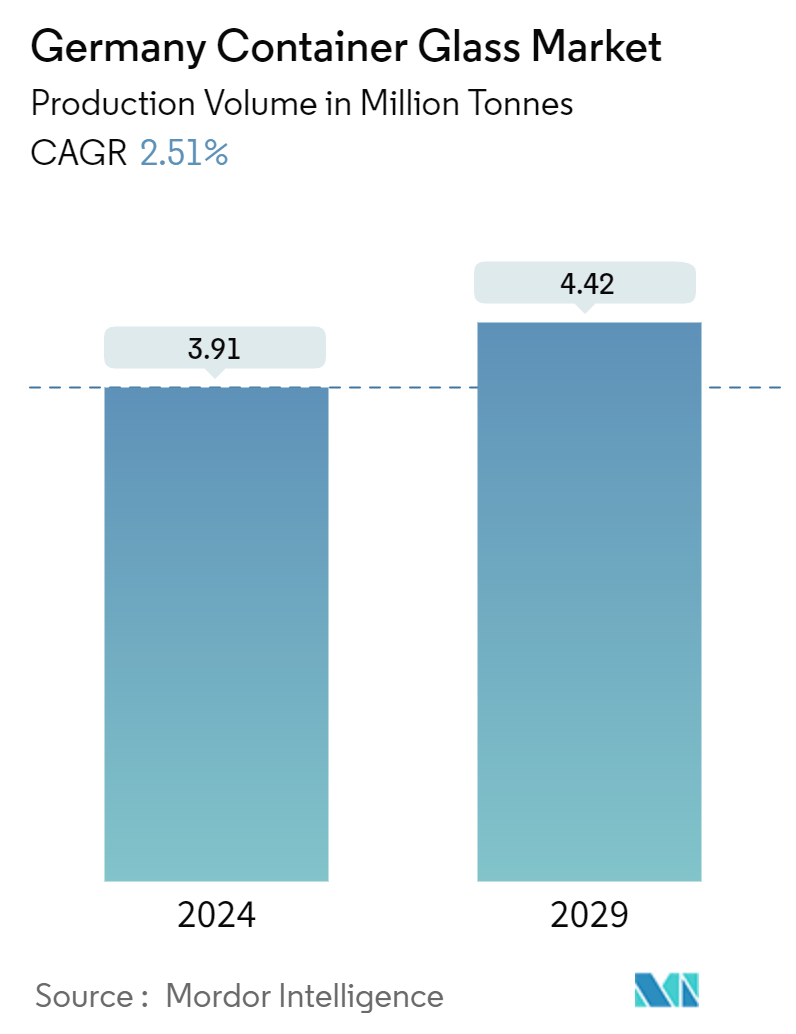
| Study Period | 2019 - 2029 |
| Base Year For Estimation | 2023 |
| Market Volume (2024) | 3.91 Million tonnes |
| Market Volume (2029) | 4.42 Million tonnes |
| CAGR (2024 - 2029) | 2.51 % |
| Market Concentration | Low |
Major Players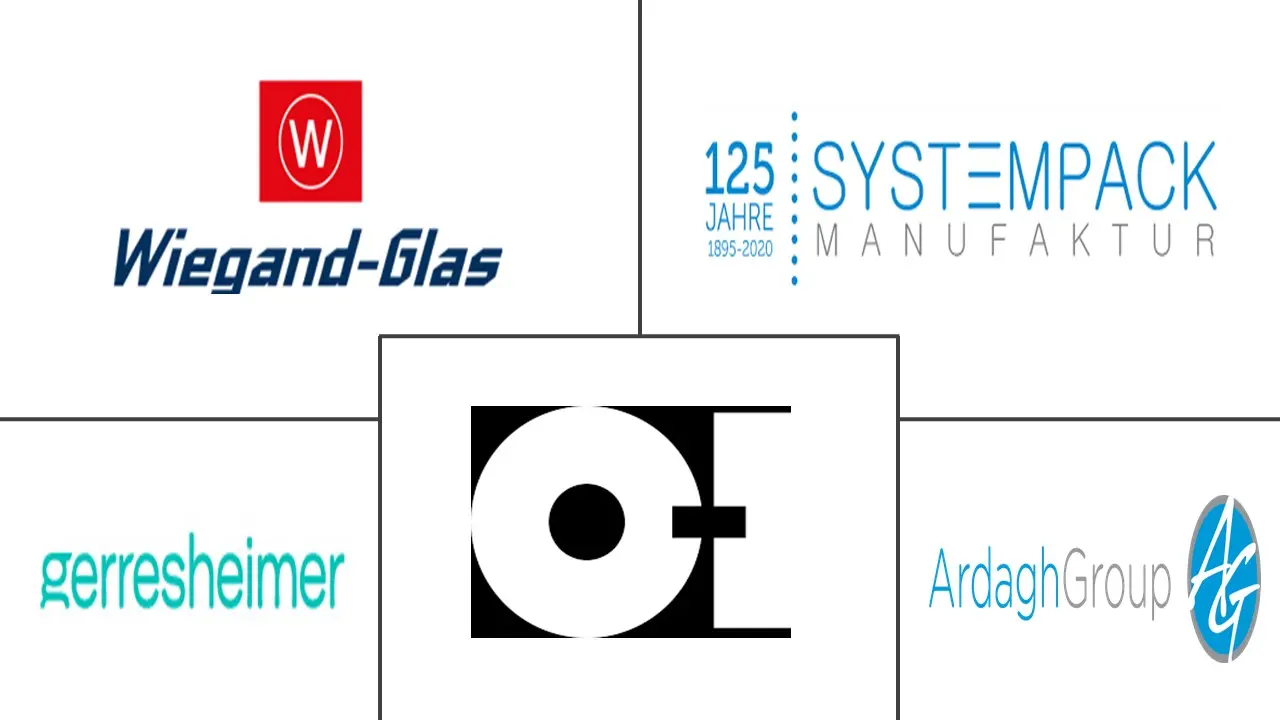
*Disclaimer: Major Players sorted in no particular order |
Germany Container Glass Market Analysis
The Germany Container Glass Market size in terms of production volume is expected to grow from 3.91 Million tonnes in 2024 to 4.42 Million tonnes by 2029, at a CAGR of 2.51% during the forecast period (2024-2029).
- The demand for packed food and beverage items has driven the need for container glass to store a diverse array of food ingredients. Container glass stands out as a preferred packaging material due to its attributes: sterility, reusability, chemical stability, durability, non-permeability, and malleability.
- With retail sales on the rise, manufacturers are increasingly adopting innovative packaging solutions to engage consumers. Container glass packaging, celebrated for its creative and distinctive designs, ensures products catch the eye on store shelves. This trend is accelerating the shift towards glass as a favored packaging medium.
- Data from Federal Statistics Germany (Statistisches Bundesamt) reveals that retail sales revenue climbed from EUR 577.4 billion (USD 624.89 billion) in 2020 to EUR 650.3 billion (USD 703.78 billion) in 2023. Such rising retail sales often indicate market growth, paving the way for new products and expanding the presence of existing ones.
- Germany is home to key players like Gerresheimer AG and Wiegand-Glas Holding GmbH, supplying container glass products to various sectors, including food and beverage. Wiegand-Glas Holding GmbH operates across eight locations with multiple business units. The company not only manufactures a wide array of glass products but also offers services like decoration, logistics, and recycling, boasting an annual production of over 8 million glass containers.
- Moreover, as reported by Germany Trade and Invest, Germany stands as the leading pharmaceutical market in Europe, hosting over 500 pharmaceutical companies. The demographic shift, with nearly half of the population over 45, fuels the demand for container glass in the pharmaceutical sector.
- In Germany, around 9,000 individuals are employed across 12 independent companies in the container glass sector. Many of these manufacturers are global players with production facilities not just in Germany, but also in other European countries and the USA, producing a wide spectrum of glass packaging products, as highlighted by the Federal Association of the German Glass Industry (BV Glas).
- However, the container glass market faces stiff competition from alternative packaging materials like plastic and aluminum. These alternatives, being lighter, less fragile, and sometimes more economical, attract cost-sensitive consumers. The energy-intensive nature of glass production leads to higher operational costs, making profit margins susceptible to energy price fluctuations.
Germany Container Glass Market Trends
Pharmaceutical Sector to Witness Significant Growth
- Germany stands as the premier hub for pharmaceutical manufacturing and R&D within the European Union. Home to globally recognized pharmaceutical glass packaging giants like Gerresheimer AG, these firms are consistently broadening their regional presence through new product launches and expanding their capacities.
- Germany offers an optimal setting for the development and production of high-grade, research-intensive products. Recent data from the European Federation of Pharmaceutical Industries and Associations (EFPIA) underscores Germany's dominance in R&D spending within the pharmaceutical sector, outpacing Switzerland, the U.K., and France, with an investment of EUR 8,540 million.
- Data from Statistisches Bundesamt (Federal Statistics Office) reveals that Germany's wholesale pharmaceutical goods revenue was USD 201.33 billion in 2020, with projections reaching USD 220.34 billion by 2024. This anticipated growth in pharmaceutical goods presents lucrative opportunities for the container glass market.
- As highlighted by BV Glas, Germany's glass industry caters to the pharmaceutical sector with a wide array of container glass products, including essential items like medicine bottles. The industry's dynamic nature is evident, with innovations such as the emergence of lightweight glass bottles and the debut of UV-resistant white glass.
- Given the stringent regulations in the pharmaceutical sector, glass packaging stands out, aligning seamlessly with the rigorous standards set by health authorities, especially concerning purity and hygiene. Furthermore, glass's inherent recyclability and reusability resonate with the pharmaceutical industry's growing emphasis on sustainability. As manufacturers increasingly prioritize eco-friendly packaging solutions, glass often surpasses plastic alternatives in fulfilling these green standards.
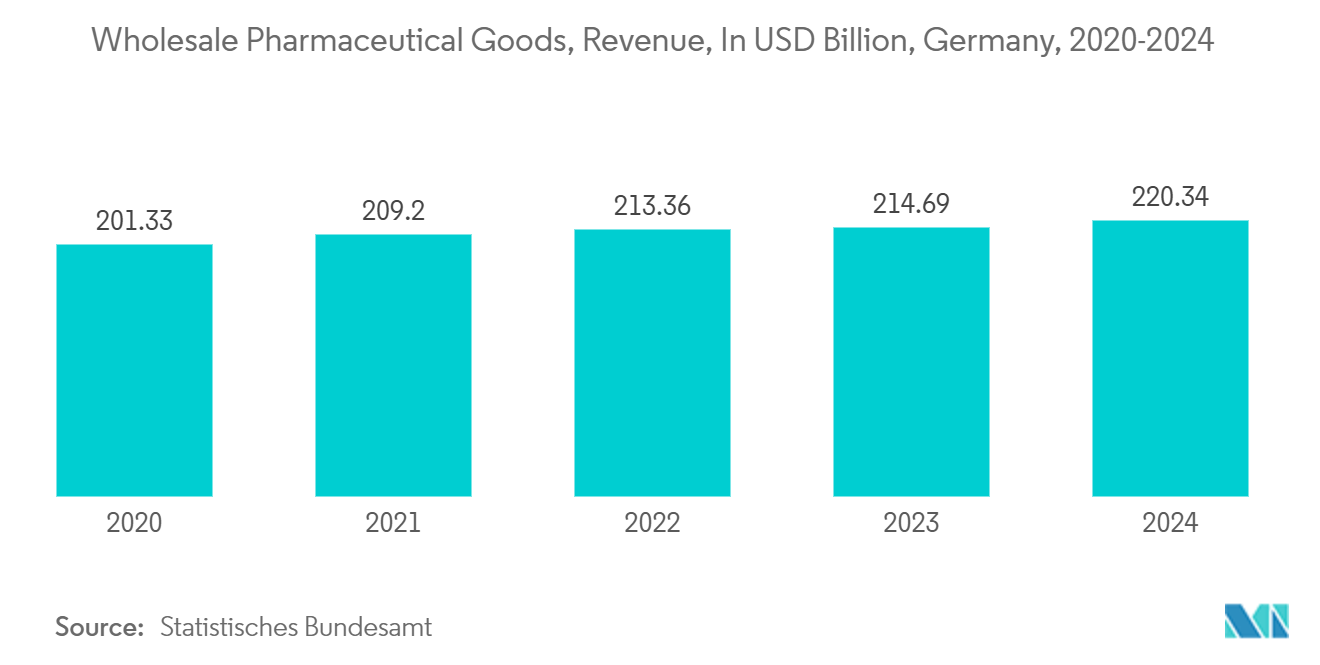
Strong Demand in Beverage Packaging Sector To Drive Market Growth
- Container glass is often chosen for packaging dairy products, like milk, due to its ability to maintain freshness and preserve taste without introducing unwanted flavors. Given that Germany contributes to the EU's drinking milk production, there's a likely sustained preference for glass packaging in the country, bolstering growth in the glass bottle packaging market. Agriland Media reported in November 2023 that Germany represented 19% of the EU's total drinking milk production.
- German consumers prioritize high-quality products and sustainable packaging. Glass containers, often viewed as more eco-friendly than their plastic counterparts, resonate with the rising sustainability trend. Consequently, the demand for glass packaging in Germany is poised to grow, driven by its perceived quality and environmental advantages.
- Aligned with the health and convenience megatrend, Germany Trade and Invest notes the industry's focus on segments like functional, organic, and sugar-free soft drinks. New entrants can carve a niche by highlighting health benefits or distinctive production methods. In the alcoholic beverages domain, growth is currently observed in craft beer variants, such as pale ale, wheat, lager, and even alcohol-free options.
- Germany is actively involved in the import and export of glass packaging products. Data indicates that exports of glass products surged from USD 12,85,746 thousand to USD 19,59,662 thousand in 2023. Moreover, Statistisches Bundesamt reports that revenue from beverage manufacturing in Germany was USD 32.02 billion in 2020, with projections reaching USD 35.15 billion in 2024. Thus, the uptick in glass product exports and beverage manufacturing suggests a robust demand for the glass packaging market in the coming years.
- Asian beer brands are increasingly popular in Germany. The non-alcoholic beer segment is witnessing a surge, with forecasts estimating its market volume to reach EUR 1.8 billion (USD 1.94 billion) by 2025. Additionally, evolving consumer preferences have led to a rise in the consumption of organic wines, beers, and spirits. As beverage consumption grows, so does the demand for container glass.
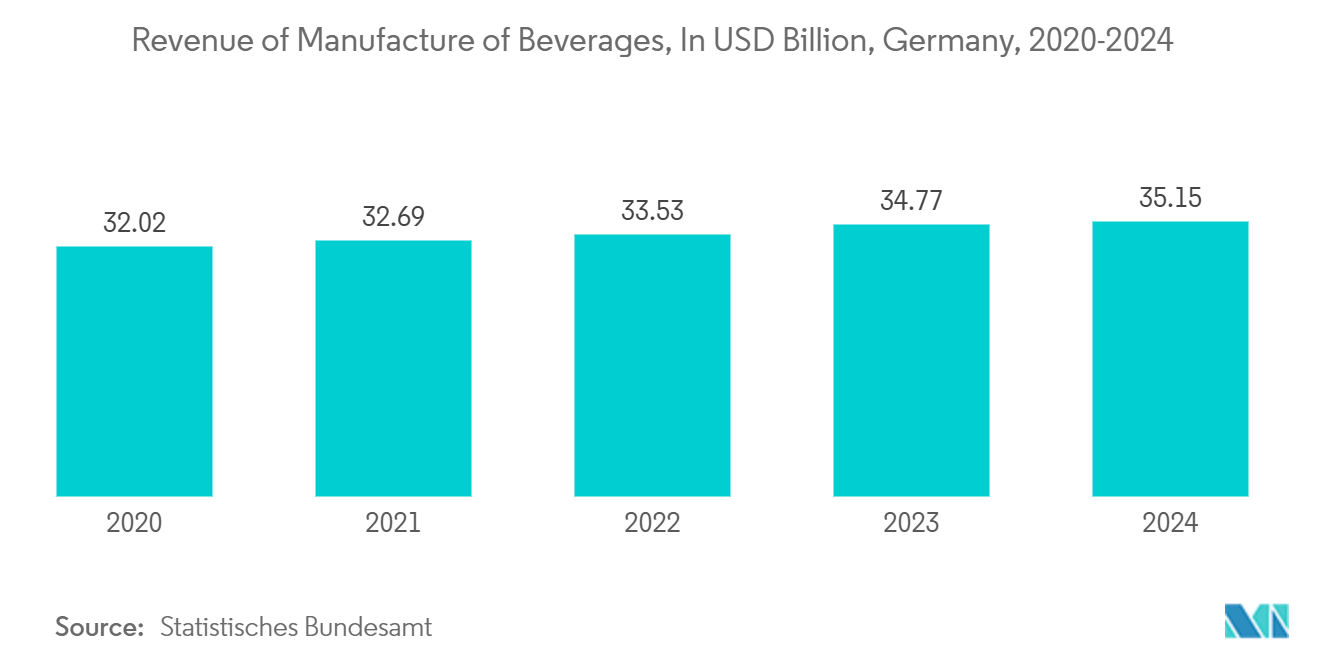
Germany Container Glass Industry Overview
The Germany container glass market is fragmented, with numerous regional and global players. Companies in the market are leveraging strategic collaborative initiatives to increase their market share and profitability. Additionally, the increasing preference for craft beer brewed locally by small and large breweries is forcing glass packaging manufacturers to adjust their production and, in some cases, switch to other growth areas, such as food and beverage and cosmetics.
Germany Container Glass Market Leaders
-
Gerresheimer AG​
-
Systempack Manufaktur GmbH
-
Ardagh Group
-
O-I Germany GmbH & Co. KG
-
Wiegand-Glas GmBH
*Disclaimer: Major Players sorted in no particular order
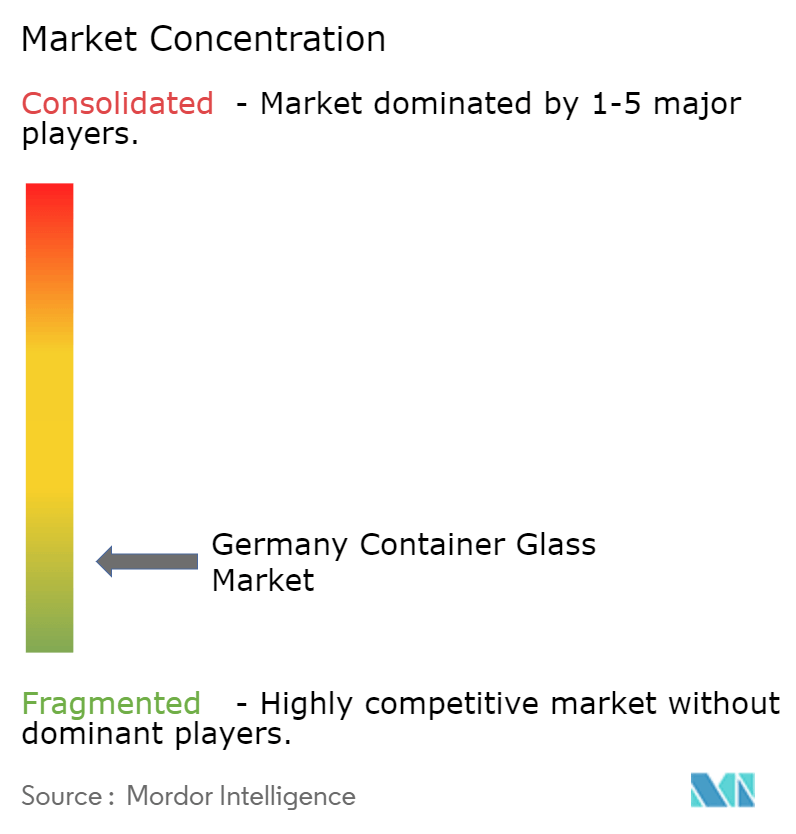
Germany Container Glass Market News
- September 2024: HEINZ-GLAS is making strides towards a sustainable future with the inauguration of its all-electric glass melting furnace in Piesau, Germany. Named 'Edith', this new electric furnace plays a crucial role in HEINZ-GLAS Group's ambition for fossil-free glass production in Piesau. With a daily capacity of 70 tonnes, the furnace underscores the company's dedication to sustainability and climate protection, operating on CO2-free electricity rather than traditional fossil natural gas.
- June 2024: Since the start of 2024, Ardagh Glass Packaging-Europe (AGP-Europe), a division of Ardagh Group, has reported a consistent 64% reduction in CO2 emissions from its innovative hybrid NextGen Furnace, amounting to savings of approximately 18,000 tonnes of CO2.
Germany Container Glass Market Report - Table of Contents
1. INTRODUCTION
1.1 Study Assumptions and Market Definition
1.2 Scope of the Study
2. RESEARCH METHODOLOGY
3. EXECUTIVE SUMMARY
4. MARKET INSIGHTS
4.1 Market Overview
4.2 PESTEL ANALYSIS - Container Glass Industry in Germany
4.3 Industry Standards and Regulations for Container Glass for Packaging
4.4 Raw Material Analysis & Material Considerations for Packaging
4.5 Sustainability Trends for Packaging
4.6 Container Glass Furnace Capacity and Location in Germany
5. MARKET DYNAMICS
5.1 Market Drivers
5.1.1 Consumers Opting for Glass Packaging as a Safer and Premium Product
5.1.2 End-user Industries Such as Pharmaceutical and Others to Drive Demand
5.2 Market Restraints
5.2.1 Demand for Alternative Materials, Destocking Effects Might Impact the Market
5.3 Analysis of the Current Positioning of Germany in the European Container Glass Market
5.4 Trade Scenario - Analysis of the Historical and Current Export-Import Paradigm for the Container Glass Industry in Germany
6. MARKET SEGMENTATION
6.1 End-user Industry
6.1.1 Beverages
6.1.1.1 Alcoholic Beverages
6.1.1.2 Non-Alcoholic Beverages
6.1.2 Food
6.1.3 Cosmetics
6.1.4 Pharmaceuticals
6.1.5 Other End-user Industries
7. COMPETITIVE LANDSCAPE
7.1 Company Profiles
7.1.1 Gerresheimer AG
7.1.2 KP Glas GmbH & Co KG
7.1.3 Wiegand-Glas GmBH
7.1.4 Rixius AG
7.1.5 HEINZ-GLAS GmbH
7.1.6 Systempack Manufaktur GmbH
7.1.7 Ardagh Group
7.1.8 O-I Germany GmbH & Co. KG
- *List Not Exhaustive
8. SUPPLEMENTARY COVERAGE - ANALYSIS OF MAJOR FURNACE SUPPLIERS TO CONTAINER GLASS PLANTS IN GERMANY
9. FUTURE OUTLOOK OF THE MARKET
Germany Container Glass Industry Segmentation
Glass Containers refer to clean bottles and jars made from glass. The scope excludes windows and other non-container glass products. Container glass is used in the alcoholic and non-alcoholic beverage industries due to its ability to maintain chemical inertness, sterility, and non-permeability. Glass packaging is valued for its unique properties, including its transparency, inertness, and ability to preserve the quality and integrity of its contents.
Germany Container Glass Market is Segmented by End-User Industry (Beverage, (Alcoholic Beverages, Non-Alcoholic Beverages), Food, Cosmetics, Pharmaceuticals, and Others). The Market Sizes and Forecasts are Provided in Terms of Volume (Tonnes) for the Above Segments.
| End-user Industry | ||||
| ||||
| Food | ||||
| Cosmetics | ||||
| Pharmaceuticals | ||||
| Other End-user Industries |
Germany Container Glass Market Research FAQs
How big is the Germany Container Glass Market?
The Germany Container Glass Market size is expected to reach 3.91 million tonnes in 2024 and grow at a CAGR of 2.51% to reach 4.42 million tonnes by 2029.
What is the current Germany Container Glass Market size?
In 2024, the Germany Container Glass Market size is expected to reach 3.91 million tonnes.
Who are the key players in Germany Container Glass Market?
Gerresheimer AG​, Systempack Manufaktur GmbH, Ardagh Group, O-I Germany GmbH & Co. KG and Wiegand-Glas GmBH are the major companies operating in the Germany Container Glass Market.
What years does this Germany Container Glass Market cover, and what was the market size in 2023?
In 2023, the Germany Container Glass Market size was estimated at 3.81 million tonnes. The report covers the Germany Container Glass Market historical market size for years: 2019, 2020, 2021, 2022 and 2023. The report also forecasts the Germany Container Glass Market size for years: 2024, 2025, 2026, 2027, 2028 and 2029.
Germany Container Glass Industry Report
Statistics for the 2024 Germany Container Glass market share, size and revenue growth rate, created by ĚÇĐÄvlog´«Ă˝â„˘ Industry Reports. Germany Container Glass analysis includes a market forecast outlook to 2029 and historical overview. Get a sample of this industry analysis as a free report PDF download.



